-
Last updated on

© VNP
What landscape do you imagine when you think of Africa? Possibly the endless savannahs with some broad-crowned trees scattered here and there and herds of elephants, giraffes, water buffalos, zebras ... Or the impenetrable rainforest with its giant trees and palms, and water pools all around. Yet Africa has so much more to offer.
Spectacular nature
In Virunga National Park in North Kivu (eastern Congo) – with an area of almost 8000 km², slightly more than the provinces of Namur and Hainaut combined - you will find not only savannahs and rainforest, but also steppes, swamps and lava plains, adjacent to a majestic high mountain range. Cliffs and abrupt valleys cleave through the rugged Rwenzori mountains and their snow-capped peaks which reach a height of more than 5000 m. The volcanoes of the Virunga massif have an afro-alpine vegetation with tree ferns and lobelias, which is unique in Africa. The mountain slopes are covered in dense forests.

The Ruwenzori high mountains with its special vegetation. © VNP
In short, Virunga park is a showcase of exceptional beauty. Not surprisingly, the park is also home to an enormous biodiversity: more than 2000 higher plant species, 218 mammal species, 706 bird species, 109 reptile species and 78 amphibian species. Many species can only be found here. 22 species of apes are native to the area, including 3 great apes: the chimpanzee, the mountain gorilla and the lowland gorilla. The okapi and the antelope-like red ‘cephalophus’ are iconic species.
In addition, the Virunga forests play an important role in the climate and water management. Not only do they store an enormous amount of carbon, they also act as a sponge. Heavy showers break out on a regular basis, and the excessive rainwater is absorbed by the immense forest and only gradually released.

Mountain gorillas are an iconic species in the Virunga park. © VNP
National Albert park
The exceptional value of the area was already recognised by the Belgian colonists. In 1925, they created the National Albert park, the very first natural park in Africa. Following independence in 1960, the park was split into two parts, one of which was given to Rwanda. The current Virunga park is situated close to 4 natural parks in Uganda. All of these parks are part of the rainforests of the Congo basin.
The current Congolese government also recognises the area as a national park. Moreover, it endorses the Convention concerning the Protection of the World Cultural and Natural Heritage (UNESCO), as well as a range of other international conventions such as those on biodiversity and on international trade in endangered species (CITES). The park is managed by the Institut Congolais pour la Conservation de la Nature (ICCN).
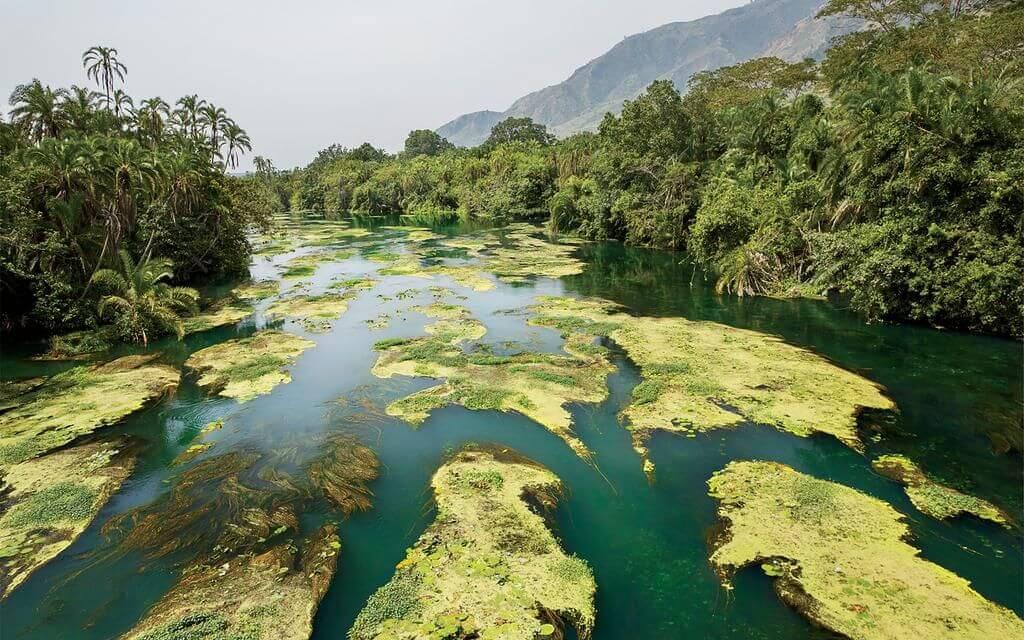
The Virunga forests play an important role in water management because they act as a sponge. © VNP
Armed groups
Unfortunately, the park has been under serious threat since 1994. Back then, large refugee camps were set up to house refugees from neighbouring Rwanda, which was being torn apart by the genocide. This led to massive deforestation and poaching. Since 1996, the impact of various armed groups involved in a tangle of conflicts in the eastern Congo has added to the problem.
These groups derive their income from a range of illegal activities, including elephant and hippo poaching, producing charcoal from coppice wood and fishing. Fishing practices – including the use of nets with small meshes - are very harmful to biodiversity. The militias easily find a market for their products through (inter)national networks of illegal trade. They have an estimated turnover of more than 50 million dollars a year.
Unprecedented poverty
There is also significant demand among local residents for charcoal and fish from the forest and for bushmeat. Around 4 million people live less than a day's walk from the reserve. The poverty and the needs of the people there are unprecedented. The nearby major cities of Goma, Beni and Butembo consume huge quantities of charcoal.
Large parts of the park are illegally occupied by farming communities. In the past there was talk of the Congolese government granting concessions for the extraction of oil. For the time being, this threat has subsided, but nothing is certain.

Park rangers on patrol in the gorilla sector in the Virunga. © VNP
717 park rangers
Clearly, protecting Virunga park is a Herculean task, if not a losing battle. Yet our compatriot Emmanuel de Merode has been doggedly devoting himself to this task for many years. With his doctorate in biological anthropology, the Congolese government saw him as the perfect man to run Virunga park. In 2008 he was appointed provincial director of the ICCN, making him a Congolese civil servant.
Among other things, De Merode is in charge of 717 park rangers, including 27 women, who have law enforcement powers under Congolese law. One component of this is the "Quick Reaction Force", made up of about 240 men, which intervenes in emergencies. All staff receive comprehensive training, with a focus on the principles of internationally applicable human rights. Virunga park also has 5 aircraft, 3 boats, 34 trucks, 40 jeeps and 1 minibus.
The main task of the park rangers is to protect the park. The patrols focus on protecting the most important species (by tackling poaching) and on illegal fishing, charcoal production and suchlike. Actions are regularly organised to regain control over the areas occupied by armed groups. This is, of course, not without risk. Over the past 20 years, more than 175 park rangers have lost their lives. De Merode was the victim of an attack himself in 2014.
Jobs, jobs, jobs
Protecting the park is one thing. Yet the only truly lasting solution is to create enough jobs for everyone. As such, this is the main goal of the "Virunga alliance", an alliance of the government, civil society and the private sector in North Kivu that was set up in 2013.
Because if local residents have a job, they will have less incentive to be involved in logging and poaching. They will also be less inclined to join a militia for lack of an alternative. Jobs therefore contribute to peace. Already today, some of the jobs created have been taken up by former militiamen.
In total, the Virunga alliance wants to create 100,000 jobs and 1 billion dollars of sustainable economic activity. The Virunga park itself provides 2500 jobs. In turn, expenditure by Virunga employees would provide a livelihood for 20,000 people (farmers, suppliers, etc.). In addition, another 17,000 indirect jobs have apparently been created.
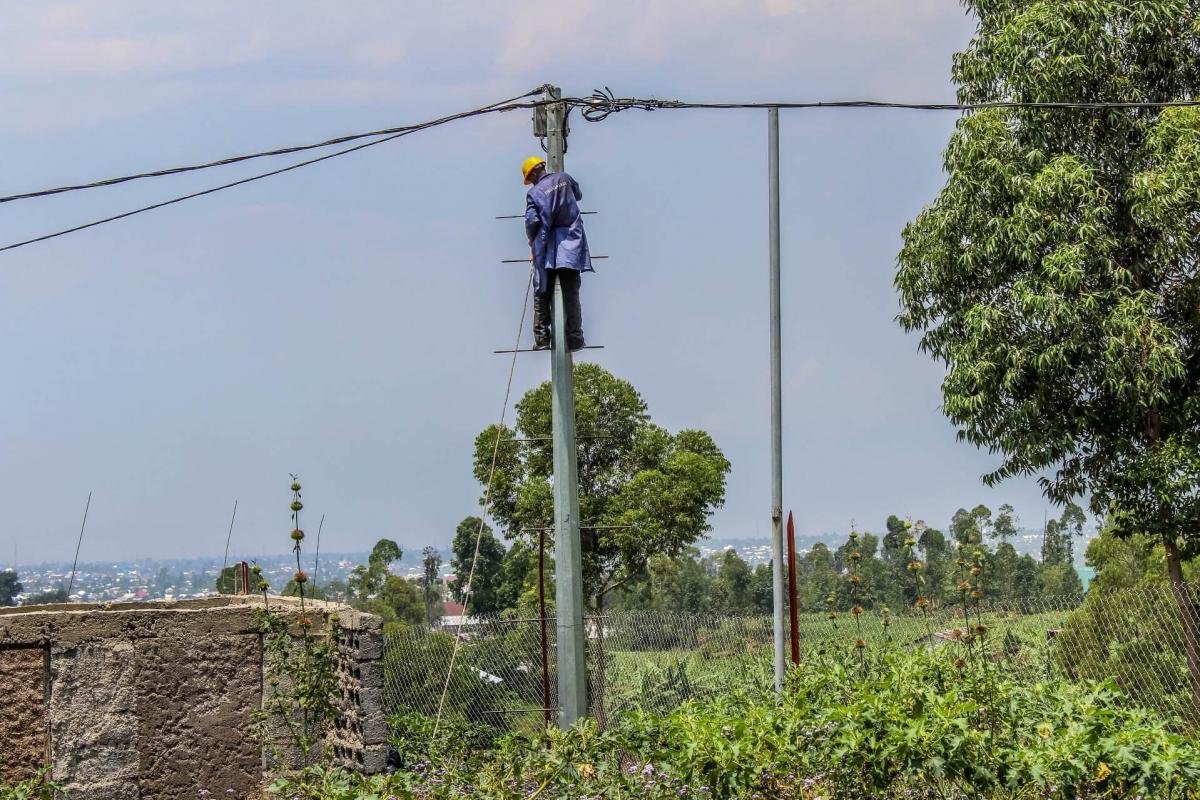
The Belgian company Ores is helping to develop an electricity grid. © VNP
Hydroelectricity plants
The indirect jobs are made possible by the supply of electricity. Virunga park, with its function as a sponge, is ideal for generating hydroelectricity. So far, 4 hydroelectric plants have been built and 4 others are in the pipeline. The potential is 105 megawatts, whereas 800 to 1000 jobs can be created per megawatt. In total, that is potentially 80,000 to 100,000 jobs.
The electricity produced must, of course, be distributed. To this end, tens of kilometres of power lines are being constructed. The Belgian company Ores, the French-speaking counterpart of Fluvius, is contributing by training technicians.
Virunga park regularly grants microcredits to starting entrepreneurs. Their activities range from fish farming and a print shop, to a shop selling computer equipment, a welding shop and a small cereal storage plant. All made possible by the supply of electricity. Moreover, safety (street lighting) and health care (better equipped hospitals) have been improved thanks to the supply of electricity.

The chocolate factory under construction! © VNP
Chocolate and soap
In addition, agriculture can be a source of job creation, especially if factories are built to process the harvests. For example, the renowned Belgian chocolatier Dominique Persoone is working together with a chocolate factory. Three types of chocolate bars will be made from locally grown cocoa beans: dark chocolate, milk chocolate and vegan. The bars will be wrapped in paper made from the leaves of the cocoa tree.
50% of the profits will go to the workers, while the other 50% will go towards protecting the park. Even though the chocolate factory will create “only” 40-50 jobs, many more cocoa farmers will finally get a decent price for their cocoa beans. The slightly more expensive Virunga bars will be sold in Belgium and other countries.

Thanks to the Sicovir soap factory, 400 decent jobs were created. © VNP
Another factory produces soap made from local palm oil. In the past, the oil was exported to Burundi and eventually returned as expensive bars of soap. Today the factory can produce 40 tonnes per day. 400 decent jobs have been created and 4000 farmers now receive at least 20% more for their palm oil.
A similar change is on the way for coffee and papaya. Thousands of local farmers produce papaya latex from which enzymes can be extracted for the pharmaceutical and food industries. In short, a lot is possible, partly thanks to the available electricity.
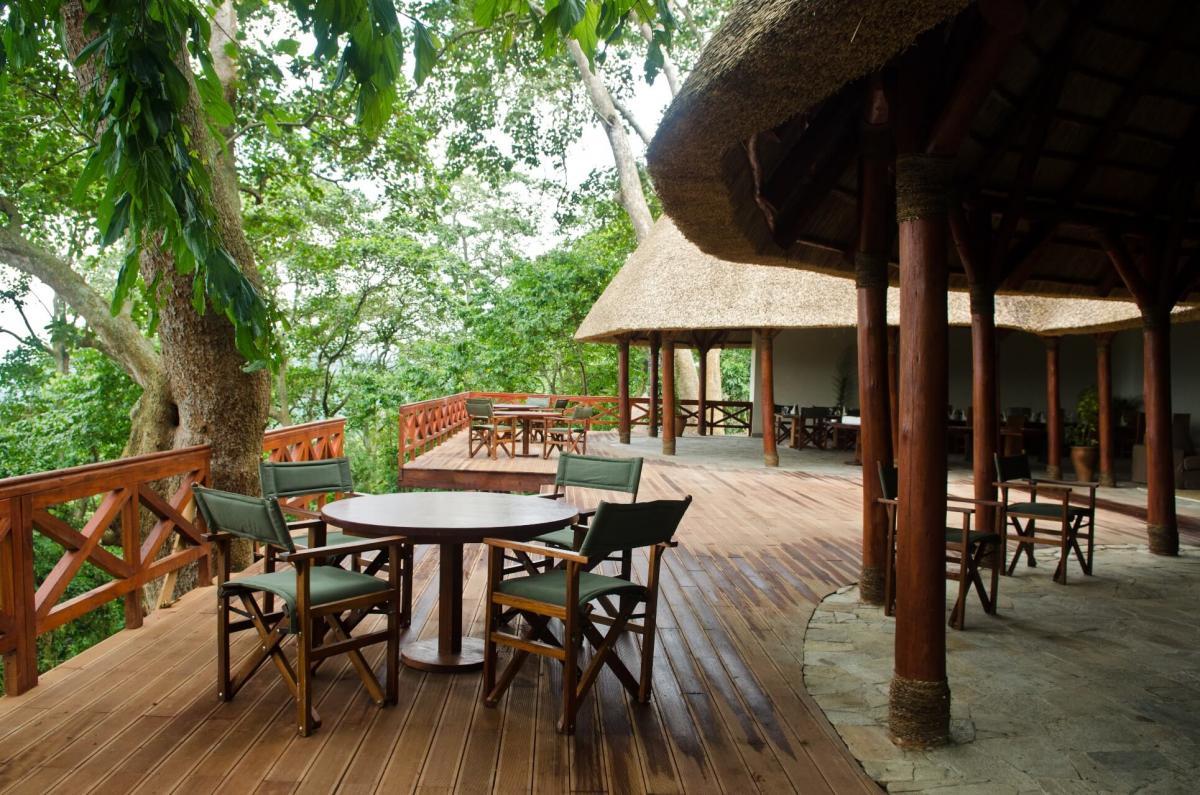
From the terrace of the cozy Mikena lodge you look straight into the jungle. © VNP
Ecotourism
A third sector which has been the focus of a lot of attention is ecotourism. This breathtaking destination clearly has enormous potential for well thought-out tourism. In 2017-2018, 5000 tourists visited the park. This generated turnover of 4 million dollars. It needs to be a whole lot more. Unfortunately, the uncertainty surrounding the elections and the Ebola outbreak ruined these plans. Hopefully the number of tourists will soon increase again.
The development of a sustainable local economy is therefore the main priority. But other measures are still necessary, such as the 100 km of electric fences currently being installed to protect biodiversity.
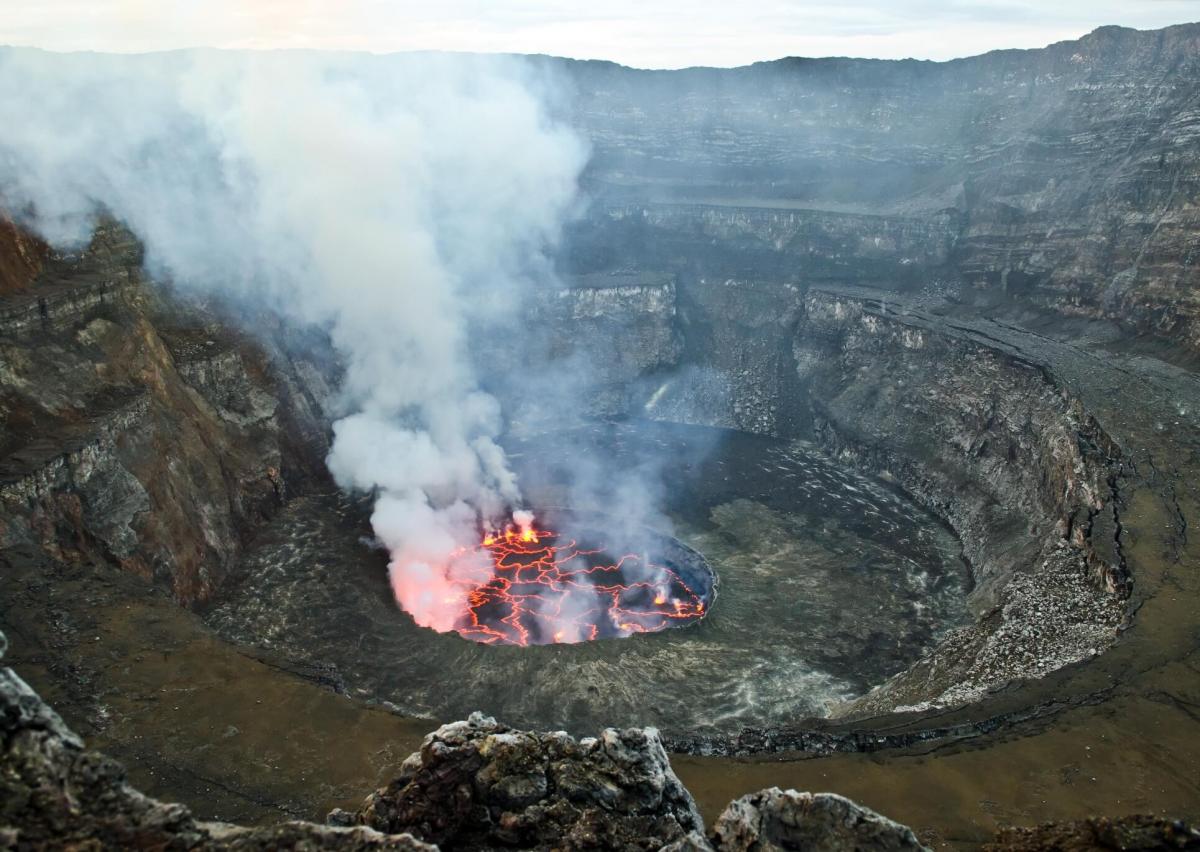
As a tourist you will also visit the spectacular crater of the Nyiragongo volcano. © VNP
Funding
It goes without saying that the costs of all these measures and investments are high. The budget for Virunga park alone amounts to about 11 million dollars a year! The European Union has been the biggest donor for 30 years. In addition, a number of smaller foundations provide financial support, in Belgium and elsewhere. (see box).
Despite the unbelievable challenges ahead, this unique treasure has a good chance of being preserved. This is thanks to the efforts of Emmanuel de Merode, the sponsors, and especially the many Congolese workers, including the park rangers who have lost their lives or still risk their lives every day.
De Merode hopes that one day, even if it takes a long time, the local residents will understand that it is worth the effort to preserve Virunga park, as it attracts tourists and is a source of energy and important investments. But it is also crucial to protect the Virunga forest for the planet as a whole.
Belgian funds
Belgian aid is provided mainly through "delegated cooperation" with the European Commission. For example, Belgium supported the construction of a micro-hydroelectric power plant on the northern border of Virunga, as well as the distribution of electricity (€3.4 million). In addition, the Virunga Foundation is contributing up to €1 million. The grants will be used to support the social and economic development of the city of Lubero.
Furthermore, Belgium has donated €325,000 to improve the training of forest rangers in the Virunga Park. In addition, the Virunga Fund Belgium raises funds from, among others, the FPS Public Health, ZOO Antwerp and Music for Life.
We should also mention the series 'Flying Doctors Virunga', which received 106,000 euros from the Belgian Development Cooperation. This popular series was broadcast in prime time on the Flemish television in 2016. To create this series, the Geronimo production company worked together with Virunga National Park and the Virunga Foundation, among others.
More on Planet

Why biodiversity is important
Find out why biodiversity is vital to humanity and the planet.
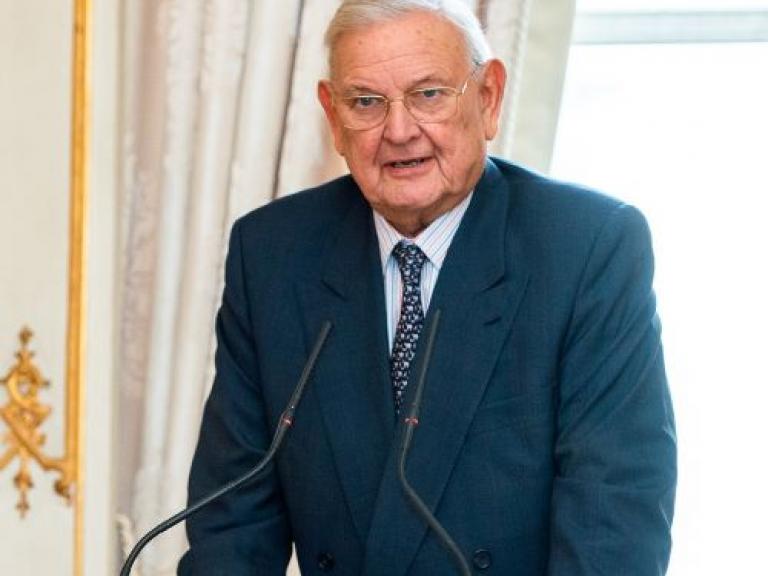
François-Xavier de Donnea: ‘The forests of the Congo Basin are threatened’
The forests of the Congo Basin are rich in natural resources. However, they are threatened by high population growth and corrupt...

12 reasons why forests are important
Forests may not often be at the forefront of our minds, but they surely are of inestimable value. In fact they are crucial to be...
